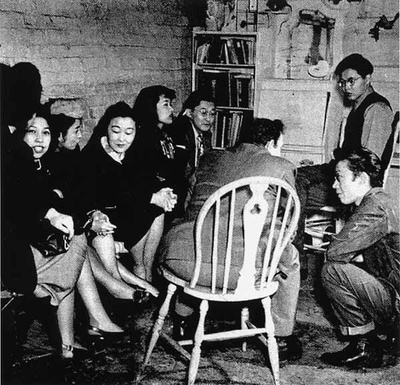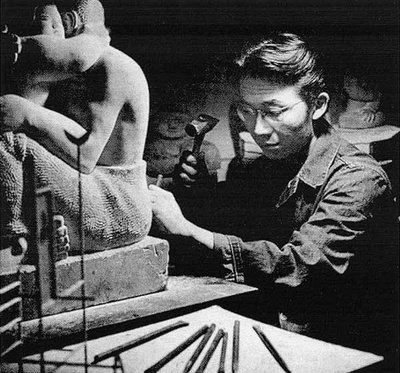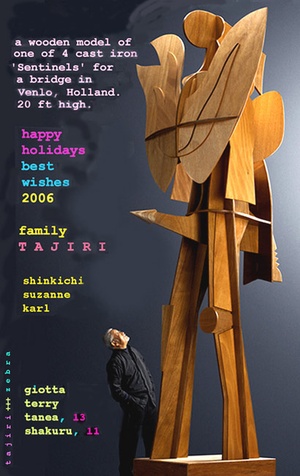Shinkichi Tajiri, a world renowned sculptor, celebrated his 80th birthday with a Netherlands exhibit showcasing many of his wonderful creations including the sculptures of 47 ronins. One of Shinkichi's earlier pieces, "Father and Son" in limestone was completed while living in Chicago in 1946. His friendship knots are well known and can be found all over the world. One is displayed outside the Japanese American National Museum in Los Angeles. "Granny Knot" is at the Rockefeller Foundation in New York City and another in Bryeres in France, commemorating 50 years of liberation by the 442nd Regimental Combat Team (RCT). In the fall of 2004, to mark the 60th anniversary, some 442nd RCT veterans including Shinkichi returned to Bryeres in remembrance. It would be wonderful to see an exhibit of Shinkichi's works in Chicago and other American cities.

Shikichi Tajiri creates the limestone sculpture "Father and Son" at his studio on Drexel Street. 1946
Tajiri is a well known name to many Japanese Americans in Chicago. Shinkichi is the fifth of seven children born to Ryukichi and Fuyo Tajiri. His oldest brother, Larry, was editor of the Pacific Citizen, the bi-monthly newspaper of the Japanese American Citizens League, during World War II. The second son died at age three in an influenza epidemic. The third son, Vincent, was part of the 442nd RCT and is best known as picture editor and director of photography of Playboy Magazine from 1954 to 1971. He edited "Through Innocent Eyes," a collection of works by Nisei. His sister, Yoshiko, edited the Tokyo area edition of the Stars and Stripes as well as other magazines. Younger than Shinkichi are twins. James was a career military officer with the rank of lieutenant colonel. He commanded Airborne Intelligence units in Vietnam and Okinawa.
Grew up in San Diego, Shinkichi always liked art. He showed his works to Ruth Hall, who introduced him to Donal Hord. Because Shinkichi couldn’t afford sculpturing lessons, he was grateful to Hord for permitting him to care for his garden in exchange for lessons. This was the beginning of sculpturing for him. The lessons ended in 1942 when his family was evacuated to Poston Concentration Camp in Arizona.
In Camp 3, Shinkichi did a series of Conte crayon drawings of camp life with art materials sent by Hord. From there, he volunteered for the 442nd RCT and joined his brother Vincent at Camp Shelby in Mississippi where they trained together.
Shinkichi was a machine gunner in Company M, Third Battalion of the 442nd RCT, which was the heavy weapons unit. He was hit on his left thigh on July 9, 1944 during an attack on Castellina, Italy. Flown to Rome, more than 50 pieces of stone were removed and he was in a cast for six months. He was transferred to Marseilles, France, and given limited duty. In 1945, he requested and was granted Special Services as an artist to sketch displaced persons from the German concentration camps. This reminded him of his days at Poston. Many of Shinkichi’s art reflect the horrors of war such as "Wounded Knee" (1953), "Scorched Earth" (1955), and "Nagasaki" (1957).
At the end of military service, Shinkichi came to Chicago to be with his mother and family. He worked at Matsumoto’s Art Shop and on the GI Bill attended the School of the Art Institute of Chicago, which he considers to be the best of the four art schools he attended. He studied art history, painting, and design. From there, he went to Paris to escape racism suffered in the U.S. and to study art with cubist sculptor, Ossip Zadkins, whom he left to have freedom to develop in his own art style.
In 1951, Shinkichi married Denise Martin and in 1956 they were divorced. Shinkichi went through lean years but earned international recognition for his art. He received a prize for the best German wallpaper design in 1953 and came to the attention of COBRA, an art group of revolutionary experimental and protestors from Copenhagen, Brussels, and Amsterdam. The Dutch group liked his works and labeled him an abstract surrealist. Shinkichi liked to experiment with art and extend himself. He considers his work the result of his life circumstances and reflects what he is attempting to solve at the moment.
In 1955, Shinkichi worked in film and his "The Viper" won the Golden Lion for the best Use of Language of Film at Cannes Festival in 1955. His "Bodil, A Summer Day" won the Grand Prix at the first Wet Dream Film Festival in Amsterdam in 1970.
A second marriage to Ferdi Jansen and their children, Glotta Fuyo born in 1957 and Ryu Vinci born in 1959 changed Shinkichi. Fatherhood shifted his philosophy of life from a death orientation towards life and regeneration.
In 1964, Shinkichi and his family went to the Art Institute of Minneapolis where he had a one year visiting professorship with Arnold Herstand. There he completed 25 bronze sculptures for an exhibit and created a monumental sculpture for the city of St. Paul.

Shinkichi Tajiri repainting antiques for the wealthy at Matsumoto Art Shop, 14 N. Michigan Avenue. 1947.
After his second wife died in an auto accident, Shinkichi changed his lifestyle to accommodate his two daughters. He invited Suzanne van der Capellen to join his family and married her in 1975. Now he is a proud grandparent.
Always open to new ideas, Shinkichi recently moved to using computer imaging in his art works. He is a terrific role model for new artists and wants to encourage Asian Americans to do art. To share what he had accomplished, Shinkichi donated books and materials to Japanese American organizations. The Chicago Japanese American Historical Society (CJAHS) was the recipient of ten books, posters, and other valuable materials. We remain very grateful. Shinkichi’s childhood friend, Noriko Korimita, of Champaign, Illinois, donated many of her artist friend's materials to the Hanako and Teruo Murata Book Collection at Northeastern Illinois University in Chicago. You are encouraged to read more about this living legend, Shinkichi Tajiri, the fabulous sculptor at http://www.shinkichi-tajiri.com.

Shinkichi Tajiri's 2005 holiday greetings shows him with his latest project, one of the four sentinels guarding a bridge.
* This article was originally publised in the Voices of Chicago by the Chicago Japanese American Historical Society.
© 2006 Chicago Japanese American Historical Society




